Trichotillomania or hair-pulling disorder is a mental health condition characterized by compulsive hair-pulling impulses. It is closely related to mental health, as it often arises as a coping mechanism for emotional challenges.
What Is Trichotillomania?
Trichotillomania is a mental health condition [mfn] Pereyra, A. D., & Saadabadi, A. (2021). Trichotillomania. PubMed; StatPearls Publishing. Available from: https://www.ncbi.nlm.nih.gov/books/NBK493186/ [/mfn] characterized by a recurrent and irresistible urge to pull out one’s hair, resulting in noticeable hair loss and distress. This condition falls under the category of Obsessive-Compulsive and Related Disorders [mfn] Administration, S. A. and M. H. S. (2016, June 1). Table 3.27, DSM-IV to DSM-5 Trichotillomania (Hair-Pulling Disorder) Comparison. Www.ncbi.nlm.nih.gov. Available from: https://www.ncbi.nlm.nih.gov/books/NBK519704/table/ch3.t27/ [/mfn] in the Diagnostic and Statistical Manual of Mental Disorders, Fifth Edition (DSM-5).
Trichotillomania is considered an impulse control disorder, as individuals with this condition find it challenging to resist the compulsion to pull out their hair. This behavior is typically triggered by stress, anxiety, boredom, or other emotional states. Hair-pulling can occur from any part of the body, but it is most commonly focused on the scalp, eyebrows, and eyelashes.
Trichotillomania In Films
Compared to mental health disorders like anxiety or depression, trichotillomania has limited representation in films. Young Adult (2011) sees Charliz Theron’s Mavis Gary struggle with trichotillomania and its impact on her personal life. Creep 2 (2017) sees the central protagonist, a serial killer, ‘catch’ the disorder after killing a man with trichotillomania. Other movies like Friend Request (2016) and Alice, Darling (2022), and the drama series Sharp Objects (2018) feature characters coping with trichotillomania.
Prevalence Of Trichotillomania
Trichotillomania is a relatively common disorder affecting 1-2% of the global population [mfn] Franklin, M. E., Zagrabbe, K., & Benavides, K. L. (2011). Trichotillomania and its treatment: a review and recommendations. Expert review of neurotherapeutics, 11(8), 1165–1174. https://doi.org/10.1586/ern.11.93 [/mfn] . It exhibits a notable gender difference, with a higher prevalence in females, compared to males. Research suggests that approximately 70-90% of diagnosed cases are female. The typical age of onset is around 9-13 years old [mfn] Grant J. E. (2019). Trichotillomania (hair pulling disorder). Indian journal of psychiatry, 61(Suppl 1), S136–S139. https://doi.org/10.4103/psychiatry.IndianJPsychiatry_529_18 [/mfn] , although some individuals may develop the signs of trichotillomania in adulthood.
Signs Of Trichotillomania
Research [mfn] Cisoń, H., Kuś, A., Popowicz, E., Szyca, M., & Reich, A. (2018). Trichotillomania and Trichophagia: Modern Diagnostic and Therapeutic Methods. Dermatology and therapy, 8(3), 389–398. https://doi.org/10.1007/s13555-018-0256-z [/mfn] attributes the common signs of trichotillomania to the following:
- Recurrent hair-pulling
- Noticeable hair loss
- Focused on specific body areas (e.g., scalp, eyebrows)
- Tension or anxiety before pulling
- Pleasure, relief, or gratification during pulling
- Attempts to stop or reduce hair-pulling
- Social or occupational impairment
- Significant distress or emotional impact
What Causes Trichotillomania?
Studies [mfn] Parakh, P., & Srivastava, M. (2010). The many faces of trichotillomania. International journal of trichology, 2(1), 50–52. https://doi.org/10.4103/0974-7753.66916 [/mfn] on what causes trichotillomania have pointed to the following factors:
- Genetics
- Stress and emotional triggers
- Family history of a similar disorder
- Neurotransmitter imbalances
Read More About Genetics Here
The Mental Health Impact Of Trichotillomania
Trichotillomania can have a profound and often debilitating impact [mfn] França, K., Kumar, A., Castillo, D., Jafferany, M., Hyczy da Costa Neto, M., Damevska, K., Wollina, U., & Lotti, T. (2019). Trichotillomania (hair pulling disorder): Clinical characteristics, psychosocial aspects, treatment approaches, and ethical considerations. Dermatologic therapy, 32(4), e12622. https://doi.org/10.1111/dth.12622 [/mfn] on an individual’s mental health. Those affected often experience intense feelings of shame, embarrassment, and frustration due to their inability to control the hair-pulling impulses. The visible hair loss can lead to lowered self-esteem, body image issues, and social withdrawal, further exacerbating their emotional distress.
Anxiety and depression are common co-morbid conditions, as individuals coping with trichotillomania grapple with the emotional toll of this disorder. The constant preoccupation with hair-pulling and the resulting damage can interfere with daily life, work, and relationships, amplifying the mental health burden. Additionally, the stigma and secrecy associated with trichotillomania can dissuade the sufferer from seeking assistance, thereby exacerbating its effects on mental health.
Trichotillomania In Children And Adults
Trichotillomania can manifest differently in children and adults, with unique considerations for each age group. In children, this condition often begins during pre-adolescence, around 9-13 years old [mfn] Walther, M. R., Ricketts, E. J., Conelea, C. A., & Woods, D. W. (2010). Recent Advances in the Understanding and Treatment of Trichotillomania. Journal of cognitive psychotherapy, 24(1), 46–64. https://doi.org/10.1891/0889-8391.24.1.46 [/mfn] , and can be challenging to detect, as children may try to conceal their hair-pulling behaviors. Parents and caregivers may notice unexplained hair loss, bald patches, or a decrease in the child’s self-esteem, academic performance, and social interactions.
In adults, the signs of trichotillomania can be equally distressing [mfn] Kaur, H., Chavan, B. S., & Raj, L. (2005). Management of trichotillomania. Indian journal of psychiatry, 47(4), 235–237. https://doi.org/10.4103/0019-5545.43063 [/mfn] . This condition may have persisted from childhood or developed in adulthood. Adults with trichotillomania may experience heightened self-consciousness, as the visible hair loss can be especially problematic in professional and social settings.
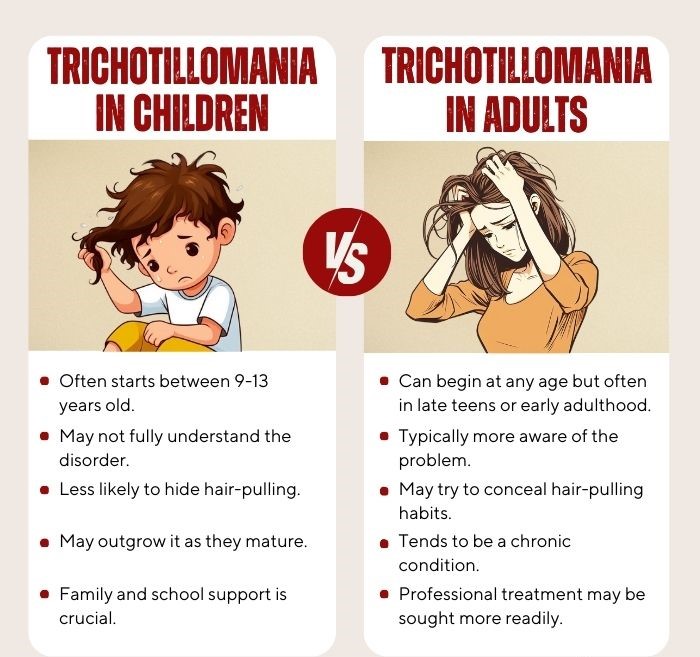
How Mental Illness Leads To Trichotillomania
Common mental health disorders associated with trichotillomania include [mfn] Huynh, M., Gavino, A. C., & Magid, M. (2013). Trichotillomania. Seminars in cutaneous medicine and surgery, 32(2), 88–94. https://doi.org/10.12788/j.sder.0007 [/mfn] :
1. Obsessive-compulsive disorder (OCD):
Commonalities include repetitive, compulsive behaviors and obsessive thoughts related to hair-pulling.
Read More About Obsessive-Compulsive Disorder (OCD) Here
2. Anxiety disorders:
Frequently co-occur with trichotillomania, including generalized anxiety disorder, social anxiety disorder, and panic disorder.
Read More About Anxiety Here
3. Depressive disorders:
Emotional distress from trichotillomania can lead to depression due to lowered self-esteem and sadness.
4. Body dysmorphic disorder (BDD):
Trichotillomania may be linked to concerns about hair imperfections, a component of BDD.
5. Skin picking (excoriation disorder):
Both involve repetitive, self-injurious behaviors often driven by emotional distress.
6. Substance use disorders:
Some individuals with trichotillomania may turn to substances like alcohol or drugs as a way to cope with emotional challenges, leading to potential substance use disorders.
How To Diagnose Trichotillomania
Diagnosing trichotillomania involves a comprehensive assessment [mfn] Chamberlain, S. R., Odlaug, B. L., Boulougouris, V., Fineberg, N. A., & Grant, J. E. (2009). Trichotillomania: neurobiology and treatment. Neuroscience and biobehavioral reviews, 33(6), 831–842. https://doi.org/10.1016/j.neubiorev.2009.02.002 [/mfn] by a qualified mental health specialist, typically a psychologist or psychiatrist. This process begins with a clinical interview where the individual discusses their symptoms, behaviors, and medical and psychiatric history. The clinician then evaluates whether these experiences align with the specific diagnostic criteria outlined in the Diagnostic and Statistical Manual of Mental Disorders (DSM-5).
Additionally, a physical examination may be conducted to rule out medical conditions contributing to hair loss, while psychological assessments, including questionnaires and psychometric tests, help assess symptom severity and screen for comorbid mental health disorders. An accurate diagnosis is crucial for developing an effective treatment plan and support system for individuals affected by trichotillomania.
How To Treat Trichotillomania
The methods [mfn] Christenson, G. A., & Crow, S. J. (1996). The characterization and treatment of trichotillomania. The Journal of clinical psychiatry, 57 Suppl 8, 42–49. [/mfn] concerning how to treat trichotillomania include:
1. Cognitive-behavioral therapy (CBT):
CBT is the primary psychotherapeutic approach, focusing on identifying triggers, developing coping strategies, and replacing hair-pulling behaviors with healthier alternatives.
Read More About Cognitive Behavioral Therapy (CBT) Here
2. Habit reversal training (HRT):
HRT is a specialized form of CBT, specifically tailored for trichotillomania. It helps individuals become more aware of hair-pulling triggers and provides techniques to interrupt and redirect the behavior.
3. Medication:
Pharmacotherapy in trichotillomania usually involves antidepressants (like SSRIs) and amino acid supplements [such as N-Acetylcysteine (NAC)] that have shown promise in reducing hair-pulling symptoms.
Coping With Trichotillomania
Consider the following tips [mfn] Woods, D. W., & Houghton, D. C. (2014). Diagnosis, evaluation, and management of trichotillomania. The Psychiatric clinics of North America, 37(3), 301–317. https://doi.org/10.1016/j.psc.2014.05.005 [/mfn] for coping with trichotillomania:
- Identify triggers: Recognize and understand what prompts hair-pulling urges.
- Self-awareness: Become more conscious of your hair-pulling habits to intervene effectively.
- Habit replacement: Find alternative actions to replace hair-pulling, like fidget tools.
- Stress management: Learn stress-reduction techniques like meditation and deep breathing.
- Support system: Seek emotional support from friends, family, or support groups.
- Professional help: Consult with a specialist for measures on how to treat trichotillomania (like therapy).
- Keep a journal: Document episodes, triggers, and emotions to spot patterns.
- Positive reinforcement: Reward yourself for periods without hair-pulling.
- Barrier methods: Use physical barriers like gloves to deter hair-pulling.
- Mindfulness: Practice staying present to manage impulses effectively.
- Medication: Take prescribed medication for symptom management.
- Education: Learn about trichotillomania to better understand and cope with the condition.
- Patience: Progress may be gradual, so be kind and patient with yourself as you work on managing trichotillomania.
Read More About Mindfulness Here
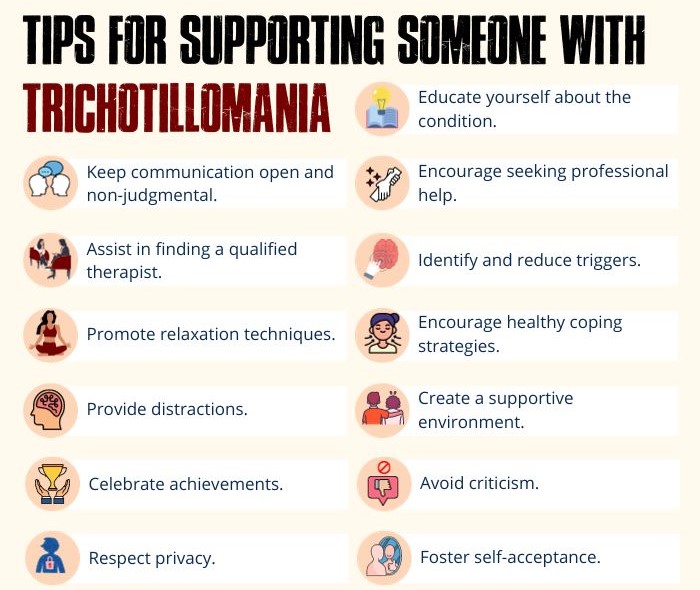
Takeaway
Trichotillomania is a challenging condition that affects individuals of various ages, often causing distress and impairment in daily life. While its precise causes remain under study, it can be effectively managed and treated through a combination of psychotherapy, medication, and self-help strategies.
Early diagnosis and intervention are crucial for individuals struggling with trichotillomania, allowing them to regain control over their behaviors and improve their overall quality of life. With the right support and a personalized treatment plan, those affected by trichotillomania can find hope and relief on their journey toward recovery.
At A Glance
- Trichotillomania is a mental health condition characterized by irresistible hair-pulling impulses.
- It is also known as hair-pulling disorder.
- Understanding what is trichotillomania and what causes trichotillomania often involve a lot of patience and empathy.
- Trichotillomania affects approximately 1-2% of the global population.
- The signs of trichotillomania often manifest in the scalp, eyebrows, and eyelashes.
- It can serve as a coping mechanism and is often challenging to stop.
- Measures on how to treat trichotillomania involve a combination of cognitive-behavioral therapy (CBT), medication, and self-help strategies.
- Coping with trichotillomania involves identifying triggers, seeking professional help, and practicing stress-reduction techniques.
Frequently Asked Questions (FAQs)
1. Is Trichotillomania A Coping Mechanism?
Trichotillomania can serve as a coping mechanism for some individuals to manage stress and emotional discomfort.
2. Is Trichotillomania Hard To Stop?
Trichotillomania can be challenging to stop due to the recurrent, compulsive nature of the behavior and the underlying emotional triggers.
3. Is Trichotillomania A Behavioural Addiction?
Trichotillomania is often considered a behavioral addiction, as it involves repetitive actions driven by psychological reinforcement.
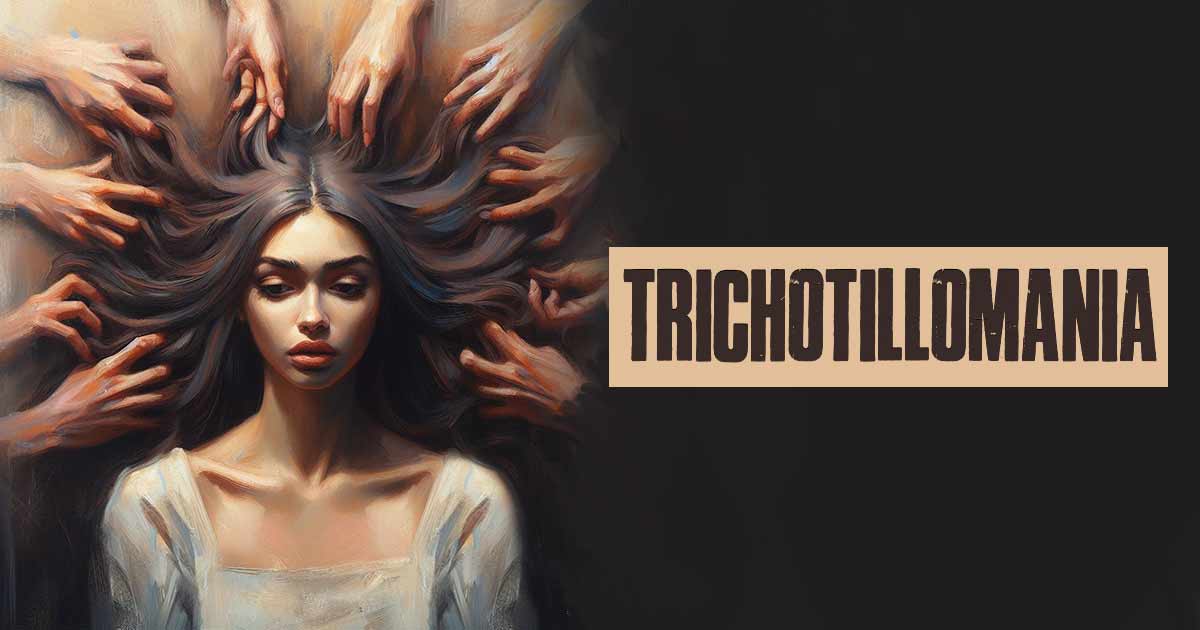

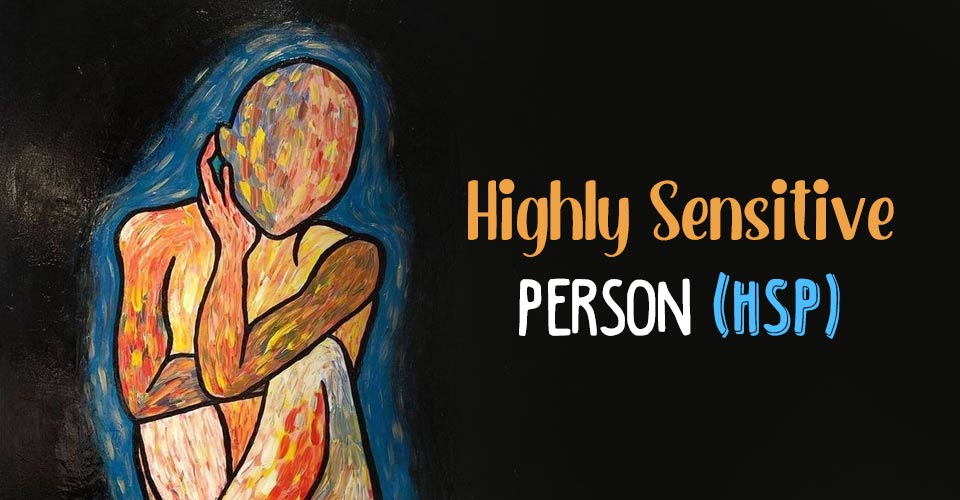
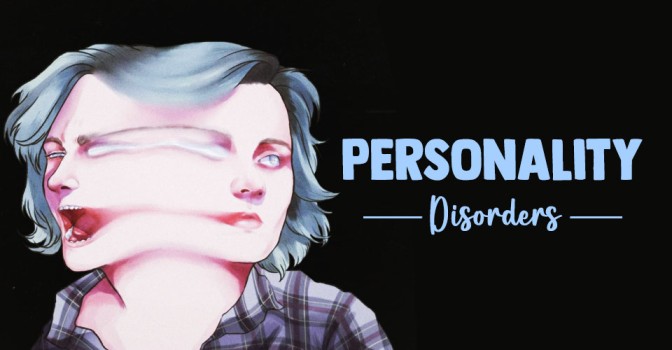
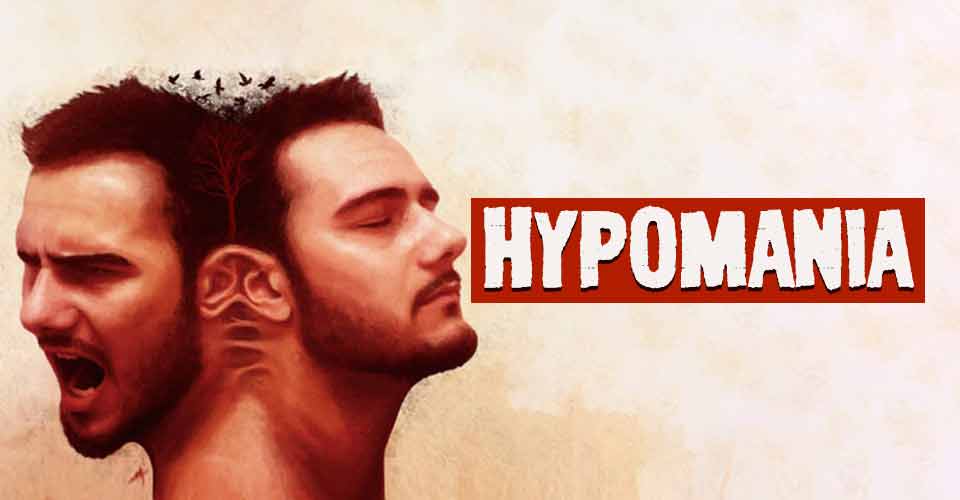
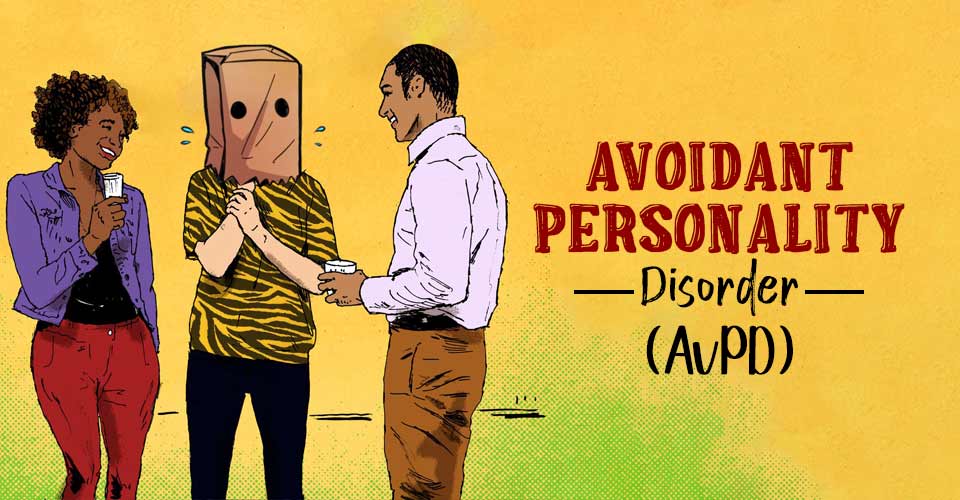

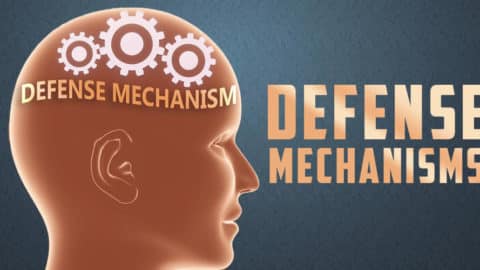
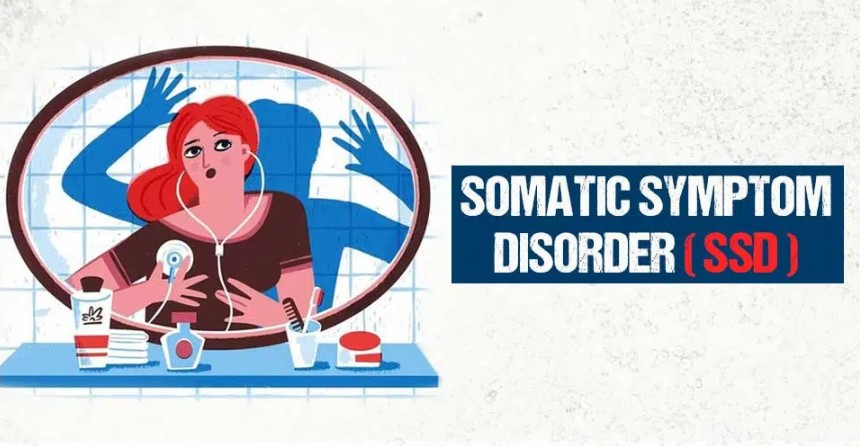

Leave a Reply